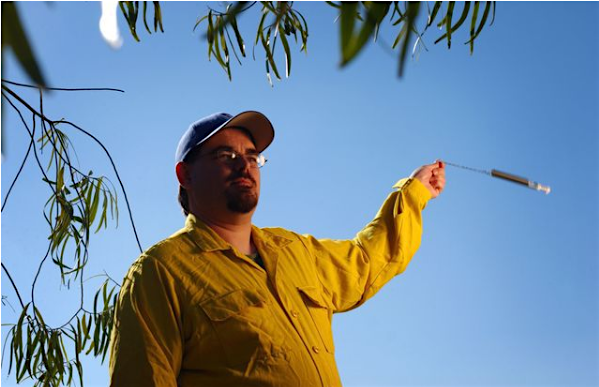This story is free to read because readers choose to support LAist. If you find value in independent local reporting, make a donation to power our newsroom today.
This archival content was originally written for and published on KPCC.org. Keep in mind that links and images may no longer work — and references may be outdated.
Thomas Fire: This weatherman tells firefighters what to expect
Meteorologist Rich Thompson’s day begins in darkness at 5:15 am when he rolls into the incident command center for the Thomas Fire at the Ventura County fairgrounds. He pulls out his laptop and checks the forecast he wrote the night before to make sure it's still current. Then he prepares for back-to-back briefings with fire chiefs and up to 800 firefighters.
The chiefs mainly want to know one thing: when will the Santa Ana winds kick up again and how bad they will be? The firefighters, though, have different questions: should they keep an eye out for lightning? What’s the wind direction today? How hot is it where I’m working?
This type of accurate, hyper-local weather information about wildfires has never been in higher demand. The National Weather Service has 80 “incident meteorologists” nationwide who are specially trained to forecast weather for wildfires, and in 2017 they spent a record 31,000 hours working on wildfires.
https://twitter.com/VCFD_PIO/status/943232527845564416
“It tells me that we’re a valued resource,” said Heith Hockenberry, the fire weather program manager at the National Weather Service. But it also may indicate that fire season is getting longer and fires are growing bigger and more complex. Indeed, this year was the most expensive ever nationwide for the U.S. Forest Service , and Cal Fire’s costs may exceed the record set in 2016.
Not every wildfire gets a weatherman – it has to be a large, complex fire involving multiple agencies. But in the biggest wildfires, which are largely driven by wind, getting accurate forecasts on wind speed, humidity and temperature is essential. In these situations, incident meteorologists can drive firefighting strategy, according to Rudy Everson, a public information officer working the Thomas Fire. “The operations section and the incident commander have to decide what they are going to be able to accomplish before the next big wind event.”
To find out when the wind will come, they turn to people like Thompson. He looks at computer models to see if high pressure is building across the Great Basin and to see if pressure is dropping along the California Coast. That can cause air to be sucked westward, increasing in speed as it comes through mountain passes. He also checks wind speeds in the upper atmosphere.

Incident meteorologists have an extensive tool box. They can strap instruments onto weather balloons and release them above a fire, allowing them to float up to 40,000 feet and burst before slowly parachuting back down, reporting data along the way. They can also deploy mobile weather stations – which have been especially helpful on the Thomas Fire, which has incinerated multiple permanent stations in the mountains of Ventura County that used to provide real-time data.
Thompson’s forecasts help drive decisions about where to deploy firefighters. For days leading up to the weekend of Dec. 16 and 17, he had been advising the operations team that the Santa Ana and Sundowner winds were going to rage and threaten Montecito. So the operations team had firefighters prepare the community, and when the winds finally began gusting at 60 miles per hour, the engines were in place. Out of 1,300 homes threatened, just 15 were damaged or destroyed, according to Everson.
“I was in awe of how they handled it,” Thompson said. “And it was nice having my forecast be a part of it. It did make me feel good.”
These kinds of experiences are why Thompson chose to be an incident meteorologist. Yes, the job frequently involves sleeping in a tent for fourteen days at a time. Yes, it involves pulling 12 hour shifts day after day. Yes, it involves breathing smoky, ash-filled air. But, he says, “I know I’m doing something immediate that is a good thing.”









